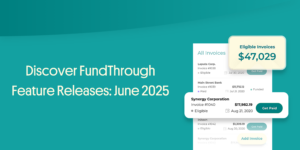
Discover What’s New: FundThrough’s June 2025 Feature Releases
We’re excited to share the latest innovations in the FundThrough platform—updates designed to make your funding experience faster, easier, and more transparent. With improvements to
By FundThrough

Home » FundThrough Blog » Small Business in 2024: Tackling High Interest Rates and Credit Crunch
Welcome to 2024, a year that’s already presenting a significant challenge for small businesses with the one-two punch of high interest rates and rising inflation. It’s a scenario that’s putting the financial resilience of entrepreneurs to the test. With the Bank of Canada’s key rate steady at 5% and similar U.S. rates peaking at a 22-year high, the cost of borrowing is on the rise. At the same time, the value of money is dwindling, making cash flow management more critical than ever for the survival and growth of small businesses.
In response, it’s crucial for small and medium-sized businesses to broaden their financial strategies. While larger corporations may have some leeway to face these financial storms, SMBs must be more strategic, exploring a variety of financing options to safeguard their operations. We’ve found that this approach is essential for SMBs aiming to not just endure but also find opportunities for growth amid these economic challenges–it all comes down to making your cash flow work for you, not against you. And you have more control over it than you might think.
“[FundThrough] allows us to develop the business faster. It gives us the confidence to go forward with cash flow to cover immediate expenses, particularly for a small business as we initially struggled with cash flow.”–David Thompson, CEO of MapleX, a growing company despite the economic climate and the COVID pandemic.
In the thick of today’s economy, small businesses are squarely facing the harsh realities of high interest rates and inflation, which together are putting a significant strain on their cash flow. High interest rates hike up the cost of borrowing, a heavy blow for small and medium-sized businesses that often rely on loans and credit lines to fuel their day-to-day operations and growth plans. Bloomberg‘s recent findings reveal a slight easing in bank lending standards, yet this is predominantly in favor of larger enterprises, with 33.9% of banks still tightening their belts on commercial and industrial loans, leaving SMBs wrestling with costlier and less accessible financing options.
Meanwhile, in Canada, the inflation scenario is intensifying the squeeze, with rates climbing to 3.4% in December, as highlighted by CBC. This uptick, fueled by factors like rising gasoline prices, persists even as the Bank of Canada holds its key rate steady at 5%. For SMBs, this means not only grappling with higher borrowing costs but also facing escalating expenses for essentials like raw materials and utilities, further complicating the task of managing a smooth cash flow.
Adding to this existing strain, companies are struggling with late payments from their customers. A study by QuickBooks tells us that 73% of surveyed businesses have been negatively affected by late payments or long payment terms, and 40% say it’s so bad, they might have to shut down if things don’t change.
The same study reveals that chasing late payments is also wasting time, with almost 10% of small business owners spending five to ten hours a week just trying to get paid. That’s 260 hours a year that could be used for growing the business instead. It’s clear how much this issue is holding them back.
“[…] with interest rates so high now, there’s an even greater incentive for these large customers to turn their much smaller suppliers into their bank (by effectively borrowing from them for free). I don’t know about you, but I just don’t think this is fair.” –Steven Uster, CEO, on how excessively long net terms hurt small businesses.
This is a wake-up call for small businesses to get creative with managing their money, turning challenges into a chance to thrive. In these challenging times, small businesses are finding a silver lining by getting smart about their cash flow.
In the quest for financial stability in 2024, small businesses are increasingly turning to alternative financing options as traditional credit avenues tighten. Let’s delve into a few of these different options, and look at valuable tips to secure alternative financing:
Invoice financing is a practical solution where businesses sell their outstanding invoices to a factoring company, transforming pending payments into immediate cash. It’s a game-changer for B2B companies caught in the cycle of extended payment terms, ensuring steady cash flow without the rigorous requirements typical of traditional banking.
Technological strides over the past decades have revolutionized invoice financing, making it more user-friendly and efficient. Today, automated platforms and AI-driven systems streamline the entire process, from invoice submission to fund disbursement, minimizing the time and effort involved. This modern approach to financing means businesses can spend less time worrying about cash flow and more time focusing on what they do best: growing and running their operations. With this tech-enabled solution, companies can access the funds they need for payroll, growth projects, and daily expenses without the debt burden, as the financial responsibility lies with the paying customers, not the business itself.
Debt to Equity Conversion: For businesses looking at long-term growth options and willing to share equity, convertible debt is a strategic choice. This financing route allows businesses to initially borrow as debt, which later converts to equity based on pre-agreed terms. It’s an attractive option for startups poised for growth, offering a bridge between initial funding rounds without the immediate repayment pressure of traditional loans.
Angel Investors: Angel investors bring more than just capital; they offer a wealth of experience and a personal stake in your success. This path is best suited for startups and early-stage companies with a compelling business model or innovative product, looking for both funding and mentorship to navigate their growth journey.
Microfinancing: Microloans are a boon for small businesses and solopreneurs lacking substantial collateral. This type of loan caters to a wide array of needs, from covering operational costs to capital investments. This option is particularly beneficial for small-scale operations and those in underserved communities, offering more accessible loan terms than traditional banking products.
Peer-to-Peer (P2P) Lending Platforms: P2P lending brings the crowdfunding spirit to business financing, connecting businesses directly with individual or institutional lenders. This is ideal for businesses seeking more flexible lending terms and those looking to diversify their funding sources beyond conventional banking.
Venture Capitalists (VCs): For high-growth potential businesses ready to scale, venture capital can provide significant funding and strategic support. The investments can propel them to new heights, in exchange for equity and a share in decision-making.
This year, the ability to face these various financing avenues effectively is pivotal for small businesses. Each option brings its unique benefits and challenges, but by utilizing a mix of these solutions to boost cash flow, businesses can ensure steady growth and resilience in the face of economic uncertainties.
If you’re ready to factor an invoice with Fundthrough, or just want to have the option in your back pocket, see if you qualify for our invoice funding solution today.

We’re excited to share the latest innovations in the FundThrough platform—updates designed to make your funding experience faster, easier, and more transparent. With improvements to

The leading fintech funding platform for SMBs secures a $25M Series B equity investment, led by Klister Credit Corp. HOUSTON and TORONTO – April 22,

Key Takeaways: Key Features to Look for in a Small Business Bank: Small business owners should prioritize customer service, security, competitive rates, and comprehensive features

Key Takeaways: Same-day business funding offers quick access to capital for emergencies, growth opportunities, and operational expenses, with options like invoice factoring, short-term loans, and

Canada’s small businesses are under siege. Ever since U.S. President Donald Trump announced a 25 percent tariff on Canadian imports, the fallout has been swift:

Key Takeaways Many alternative lenders offer business funding without conducting a credit check, focusing instead on business revenues and cash flow, providing a viable option
Interested in possibly embedding FundThrough in your platform? Let’s connect!